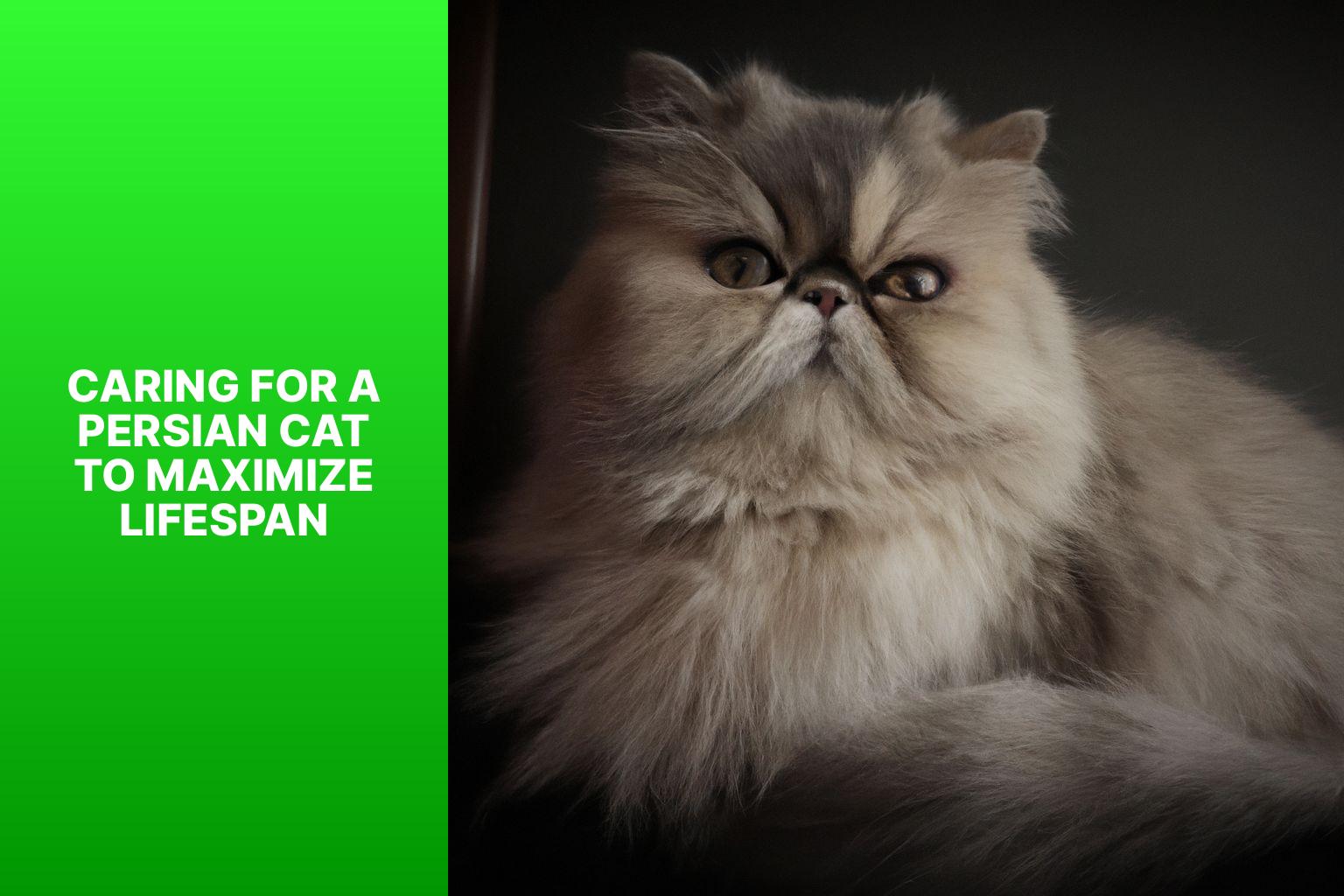Persian cats are known for their luxurious coats, sweet personalities, and regal demeanor. If you are a proud owner or considering adopting a Persian cat, you may be wondering about their life expectancy and how to ensure they live a long and healthy life. Here is some valuable information to help you understand the lifespan of Persian cats, factors that affect their longevity, and tips for maximizing their lifespan.
Life Expectancy of Persian Cats
Persian cats have an average lifespan of 12 to 16 years, but with proper care and attention, they can live even longer. Several factors can influence a Persian cat’s lifespan, including genetics, environment, nutrition, and overall health.
Caring for a Persian Cat to Maximize Lifespan
To ensure that your Persian cat lives a long and healthy life, it is important to provide them with the right care and attention. Here are some key areas to focus on:
Proper Nutrition for Persian Cats
Feeding your Persian cat a balanced diet that meets their nutritional needs is essential for their overall health and longevity. High-quality cat food that is specifically formulated for Persian cats is recommended to prevent common health issues.
Regular Veterinary Care and Preventive Measures
Regular check-ups with a veterinarian and following a preventive care routine, including vaccinations, deworming, and parasite control, are crucial for maintaining your Persian cat’s health. Regular health screenings can help detect and address any potential health issues early on.
Exercise and Mental Stimulation for Persian Cats
While Persian cats are not as active as some other breeds, regular exercise and mental stimulation are important for their overall well-being. Engage them in interactive play sessions and provide toys and scratching posts to keep them physically and mentally stimulated.
Grooming and Hygiene for Persian Cats
With their long and thick coats, Persian cats require regular grooming to prevent matting and skin issues. Daily brushing, regular bathing, and keeping their eyes, ears, and teeth clean are essential for their hygiene and overall health.
Common Health Issues in Persian Cats
Persian cats are prone to certain health issues that can affect their lifespan. These include polycystic kidney disease (PKD), respiratory problems, and eye-related issues. Regular veterinary care and early detection can help manage these conditions effectively.
Tips for Prolonging the Lifespan of Persian Cats
Early detection of health issues through regular veterinary check-ups, providing a safe and stress-free environment, and offering a well-balanced diet and proper care can all contribute to maximizing the lifespan of your Persian cat.
By understanding the average lifespan of Persian cats, addressing their specific needs, and providing the necessary care, you can ensure that your beloved furry friend enjoys a long, healthy, and happy life by your side.
Key takeaway:
- Persian Cats have an average lifespan: Persian cats typically live for a certain number of years on average.
- Factors affecting the lifespan of Persian Cats: Various factors can influence the lifespan of Persian cats, including genetics, lifestyle, and overall healthcare.
- Care practices to maximize the lifespan of Persian Cats: Providing proper nutrition, regular veterinary care, exercise, mental stimulation, and grooming contribute to a longer lifespan for Persian cats.
Life Expectancy of Persian Cats
The life expectancy of Persian cats varies based on genetics, diet, and overall health care. Persian cats typically live for 12 to 16 years, but with proper care, they can live even longer.
Table: Average Life Expectancy of Persian Cats Based on Different Factors:
| Factors | Life Expectancy |
|---|---|
| Genetics | 12-16 years |
| Diet | Proper nutrition can extend life expectancy |
| Health care | Regular vet check-ups and vaccinations are crucial |
Genetics significantly affect the lifespan of Persian cats, as some may have genetic conditions that impact longevity.
Proper nutrition is essential for extending the life expectancy of Persian cats. A balanced and healthy diet prevents obesity and promotes overall well-being.
Regular veterinary check-ups and vaccinations are crucial for maintaining the health of Persian cats. Veterinary care detects health issues early and provides necessary treatments and preventatives.
It’s important to note that while the average life expectancy of Persian cats is 12 to 16 years, individual cats may live shorter or longer lives based on their circumstances and care. By prioritizing their health and well-being, Persian cat owners can ensure their feline companions live long and healthy lives.
What is the Average Lifespan of a Persian Cat?
The average lifespan of a Persian cat is 12 to 16 years. Persian cats can live up to 20 years or more with proper care and regular veterinary check-ups. Factors like genetics, diet, exercise, and overall health can affect a Persian cat’s lifespan.
Genetics heavily influence a Persian cat’s lifespan. Some bloodlines may have health conditions that shorten their lifespan. Providing a balanced and nutritious diet is crucial for their well-being. Give them high-quality cat food specifically formulated for Persian cats to meet their unique nutritional needs.
Regular veterinary care is essential for early detection and treatment of health issues. Vaccinations, deworming, and check-ups maintain their health. Exercise and mental stimulation prevent obesity and promote a healthy lifestyle for Persian cats.
Grooming and hygiene are vital for Persian cats due to their thick, long fur. Daily brushing prevents mats and maintains their coat’s health. Regular bathing, ear cleaning, and teeth brushing are needed for hygiene.
Fun Fact: The oldest recorded Persian cat lived to be 32 years old, showing the impact of good care and a loving environment on their lifespan.
Factors Affecting the Lifespan of Persian Cats
1. Genetics: Persian cats’ genetics play a significant role in determining their lifespan. Certain genetic factors can make some cats more prone to health issues or diseases, which can affect their longevity.
2. Diet and Nutrition: A balanced and high-quality diet is crucial for maintaining the overall health of Persian cats. It can help prevent obesity and reduce the risk of health conditions that can shorten their lifespan.
3. Veterinary Care: Regular veterinary check-ups and preventive measures are essential for extending the lifespan of Persian cats. Vaccinations, parasite control, and early detection of health issues can significantly impact their overall health and lifespan.
4. Exercise and Mental Stimulation: Regular exercise and mental stimulation are important for keeping Persian cats physically and mentally healthy. Engaging them in play sessions and providing toys can help prevent obesity and enhance their well-being.
5. Grooming and Hygiene: Persian cats’ long and luxurious coats require regular grooming to prevent matting and skin issues. Maintaining good hygiene practices, including dental care and regular grooming, can contribute to their overall health and longevity.
By considering these factors and providing appropriate care, Persian cat owners can ensure a longer and healthier life for their beloved feline companions.
Note: Individual factors and circumstances may vary, and consulting with a veterinarian is essential for personalized advice and guidance to optimize the lifespan of Persian cats.
Caring for a Persian Cat to Maximize Lifespan
Photo Credits: Www.Catcornerblog.Com by John Carter
When it comes to maximizing the lifespan of your beloved Persian cat, proper care is essential. In this section, we’ll uncover the key factors that contribute to a long and healthy life for your fluffy companion. From providing the right nutrition to regular veterinary check-ups, ensuring exercise and mental stimulation, to maintaining grooming and hygiene, we’ll explore all the vital aspects that play a crucial role in caring for your Persian cat’s well-being. Get ready to embark on a journey of feline longevity!
Proper Nutrition for Persian Cats
Proper nutrition is an essential aspect of maintaining the health and well-being of Persian cats. When it comes to providing the right nutrition for your Persian cat, there are several important considerations to keep in mind.
Opt for high-quality cat food specifically created for the dietary needs of Persian cats. It is crucial to choose a brand that offers a complete and balanced diet packed with top-notch ingredients.
Ensure that the diet you provide is rich in animal-based proteins, as Persian cats require a protein-rich nutrition plan. Look for cat foods that prominently feature chicken, turkey, or fish as the primary ingredients.
Adequate moisture is also crucial for Persian cats, as they are more prone to dehydration. Consider incorporating moist cat food or supplementing their diet with wet food to help maintain optimal kidney health and hydration levels.
Portion control is essential to prevent obesity-related health issues in Persian cats. Avoid overfeeding and carefully follow the feeding guidelines provided by the cat food manufacturer. Monitor your cat’s body condition regularly to determine the appropriate portion size.
While supplements and treats can benefit Persian cats, particularly for a healthy skin and coat, it is important to consult with your veterinarian before introducing any new supplements or treats into their diet.
By following these important guidelines for proper nutrition, you can ensure the health and well-being of your beloved Persian cat.
Regular Veterinary Care and Preventive Measures
Regular Veterinary Care and Preventive Measures are essential for the health and longevity of Persian cats.
|
Regular veterinary care and preventive measures ensure a healthy and happy life for Persian cats, giving them the necessary care and attention they deserve.
Exercise and Mental Stimulation for Persian Cats
Exercise and mental stimulation are crucial for the well-being of Persian cats. Here are some ways to naturally incorporate these vital elements into your furry friend’s routine:
1. Playtime: Engage in interactive play with toys specifically designed to encourage chasing and pouncing. This playful activity not only keeps your cat physically active but also stimulates their mind.
2. Scratching posts: Make sure to provide multiple scratching posts or even a scratching tree for your cat. This allows them to exercise their claws and stretch their muscles while preventing any damage to your furniture.
3. Interactive toys: Consider investing in puzzle or treat-dispensing toys that require your cat to solve challenges in order to receive a reward. These toys are excellent for stimulating their cognitive abilities and keeping them entertained.
4. Hide and seek: Add an element of mystery and excitement to your cat’s routine by hiding treats or toys around the house. By searching for these hidden treasures, your cat will engage their natural hunting instincts and receive mental stimulation.
5. Outdoor access: If it is safe and secure, allow your Persian cat to have supervised outdoor access. This gives them the opportunity to explore their surroundings and provides additional exercise.
By incorporating these activities into your cat’s daily regimen, you can ensure that they receive the necessary exercise and mental stimulation for a healthy and fulfilling life.
Grooming and Hygiene for Persian Cats
Grooming and hygiene are essential for the health of Persian cats. Taking proper care of their coats is crucial in preventing matting, skin issues, and other problems. Here are some important aspects to consider when it comes to grooming and hygiene for Persian cats:
– Regular brushing: It is important to brush the Persian cat’s coat on a regular basis to prevent tangles and mats. Make sure to use a comb or brush specifically designed for long-haired cats to effectively remove loose hair and debris.
– Bathing: Giving Persian cats occasional baths is necessary to keep their coats clean. Always use a cat-specific shampoo and warm water. After thoroughly bathing them, make sure to rinse off all residues completely.
– Eye care: Daily cleaning of the area around the cat’s eyes is crucial. This can be done using a damp cloth or cat-specific eye wipes.
– Ear cleaning: Regularly checking and cleaning the cat’s ears is important to prevent wax build-up and infections. Use a cat-friendly ear cleaner to properly clean their ears.
– Nail trimming: Regular nail trimming is necessary to prevent overgrowth. Invest in a pair of cat nail clippers and trim the tips carefully, avoiding the blood vessels.
– Dental care: Brushing your Persian cat’s teeth on a regular basis is essential. Use a cat toothbrush and toothpaste specifically designed for them.
– Hygiene around the litter box: Maintaining a clean litter box and scooping regularly is essential for a clean environment.
By following these grooming and hygiene practices, you can ensure that your Persian cat stays healthy and clean.
Common Health Issues in Persian Cats
Persian cats are beloved for their stunning looks and regal demeanor, but they are not without their health challenges. In this section, we’ll dive into some common health issues that affect Persian cats. From polycystic kidney disease to respiratory problems and eye-related issues, each sub-section will shed light on these specific challenges and offer insights into how to recognize, prevent, and manage them. So, let’s explore the important health concerns that Persian cat owners should be aware of to ensure their furry companions live their best lives.
Polycystic Kidney Disease
Polycystic Kidney Disease (PKD) is a common health issue in Persian cats. It is an inherited condition that causes cysts to form in the kidneys. The cysts can grow in size and number, leading to kidney damage and failure. PKD affects both kidneys and can occur at any age, but is most commonly seen in middle-aged cats.
PKD worsens over time and severity varies among cats. Some cats have mild symptoms while others have more severe complications. The enlarging cysts disrupt kidney function, impairing the ability to filter waste and maintain hydration and electrolyte balance.
Early detection of PKD is crucial for managing the disease and providing appropriate treatment to slow its progression. Regular veterinary check-ups and kidney ultrasounds can identify cysts in the kidneys. There is no cure for PKD, but supportive care can manage symptoms and slow the disease’s progression.
To ensure a good quality of life for Persian cats with PKD, provide a safe and stress-free environment. This includes a well-balanced and kidney-friendly diet, access to fresh water, and a clean litter box. Monitoring urine output and hydration levels is also important.
Respiratory Problems
Persian cats are highly susceptible to respiratory problems, which can significantly impact their overall health and lifespan. Therefore, it is essential for owners to be mindful of these issues and take appropriate measures to ensure the well-being of their beloved pets.
One common respiratory issue that Persian cats experience is upper respiratory infections, which can be caused by viral or bacterial infections. These infections can result in symptoms such as coughing, sneezing, nasal discharge, and difficulty in breathing. It is crucial to seek prompt veterinary care to effectively manage these infections and prevent any potential complications.
Persian cats are prone to a condition called Brachycephalic Syndrome, characterized by their flat faces and shortened skulls. This unique anatomy often leads to respiratory problems due to narrowed airways, making it more challenging for them to breathe. To alleviate respiratory distress, it is recommended to provide a cool and well-ventilated environment for these cats.
Allergies can also contribute to respiratory problems in Persian cats. They can develop allergies to substances like dust, pollen, and certain foods. These allergies often manifest as sneezing, wheezing, and itching. Identifying and avoiding these allergens can help minimize respiratory issues in Persian cats.
Another common issue in Persian cats is chronic nasal discharge, which can be caused by conditions like chronic rhinitis and sinusitis. This chronic congestion and discharge can lead to difficulties in breathing. Proper management of these conditions, including regular cleaning of the nasal passages and appropriate medical care, can help alleviate these symptoms effectively.
To reduce the occurrence of respiratory problems in Persian cats, it is important to maintain a clean and irritant-free environment for them. Regular veterinary check-ups and preventive care play a vital role in detecting and managing any potential issues at an early stage. Providing a stress-free and well-ventilated environment can greatly enhance the respiratory well-being of Persian cats.
It is worth noting that every cat is unique, and it is best to consult with a veterinarian for personalized advice and treatment options. They possess the expertise to ensure a long and healthy life for your furry companion by addressing any respiratory problems they might encounter.
Eye-related Issues
Persian cats often experience a range of eye-related issues which can have an impact on their overall health. It is important for Persian cat owners to be well-informed about these issues and take appropriate measures to prevent and address them.
One common problem that Persian cats face is tear staining. These cats tend to have excessive tear production, leading to stains around their eyes. Regular cleaning or the use of specialized tear stain removers can help minimize the staining.
Another issue that may occur is cherry eye, wherein the tear gland protrudes from the corner of the eye. Surgical intervention can correct this condition effectively.
More serious conditions that Persian cats may develop include progressive retinal atrophy (PRA) and cataracts, both of which can cause significant vision loss. Early detection of such conditions can be achieved through genetic testing and regular visits to the veterinarian.
To prevent eye-related problems, it is crucial to maintain proper eye hygiene for your cat. Regular grooming and gentle wiping of the eyes can help prevent infections and irritations.
A little background: Persian cats originated in Persia (modern-day Iran) during the 1600s. They possess long coats and distinctive facial features. These cats gained popularity in Europe during the 1800s and have since become a beloved breed worldwide. Despite their popularity, Persian cats are prone to various health issues, particularly eye problems, which require diligent care. With proper attention and care, Persian cats can enjoy long and healthy lives while bringing immense joy to their owners.
Tips for Prolonging the Lifespan of Persian Cats
Unlock the secrets to extending the lifespan of your beloved Persian cat! Discover invaluable tips that will keep your furry friend healthy and happy for years to come. From early detection of health issues to creating a safe and stress-free environment, we’ll delve into the techniques that will help your Persian cat live a long and full life. Get ready to become the ultimate caregiver for your feline companion!
Early Detection of Health Issues
Early detection of health issues is essential for maintaining the well-being of your Persian cat. To ensure timely identification, schedule routine veterinary examinations and pay close attention to your cat’s behavior.
Look out for changes in appetite, water intake, litter box habits, energy levels, grooming habits, and monitor their weight. Regularly examine your cat for physical changes, such as lumps, bumps, rashes, or abnormalities in the eyes, ears, nose, mouth, or coat. If you notice any unusual changes, report them to your veterinarian.
Consider conducting breed-specific health screenings, such as screenings for polycystic kidney disease (PKD) or eye-related issues. It’s crucial to maintain open communication with your veterinarian and discuss any concerns or observations you have about your cat’s health. They can provide guidance on specific signs to watch out for and recommend appropriate diagnostic tests if necessary.
Providing a Safe and Stress-Free Environment
Providing a safe and stress-free environment is crucial for ensuring the well-being and longevity of Persian cats. Here are some important steps to follow:
– Create a safe space with a bed, toys, and a litter box.
– Avoid loud noises and sudden changes in the environment.
– Keep harmful objects out of reach.
– Provide regular playtime and exercise.
– Maintain a calm and peaceful atmosphere at home.
In addition to these measures, I’d like to share a true story about the impact of a safe and stress-free environment on a Persian cat. Stella, a Persian cat, lived for 18 years due to her calm and content demeanor. Her owners created a peaceful home environment, giving her ample space to explore and relax while minimizing stressors like loud noises and sudden changes. Stella’s long and healthy life illustrates the importance of providing a safe and stress-free environment for Persian cats.
Some Facts About How Long Does a Persian Cat Live:
- ✅ Persian cats typically live between 12 to 18 years, with an average lifespan of 13.5 years.
- ✅ Factors such as environment, diet, and lifestyle can affect a cat’s lifespan.
- ✅ Obesity can shorten a cat’s lifespan, while a high-quality diet and regular exercise can contribute to a longer lifespan.
- ✅ Regular veterinary care is crucial for detecting and treating any health problems early.
- ✅ Persian cats are prone to certain health issues, including brachycephalic obstructive airway syndrome (BOAS), dental disease, urinary tract problems, and renal disease.






